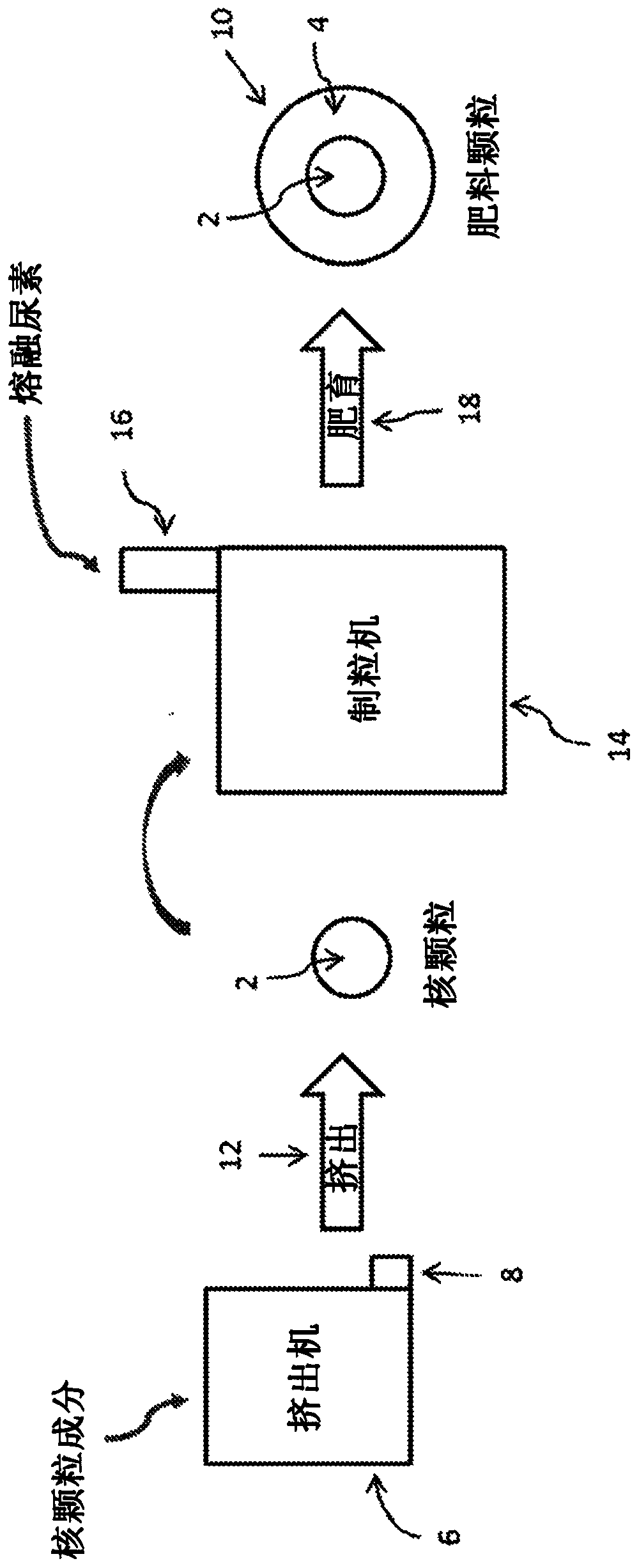Enhanced efficiency fertilizer with urease inhibitor and nitrification inhibitor separated within the same particle
A technology of urease inhibitor and nitrification inhibitor, applied in urea compound fertilizer, layered/coated fertilizer, fertilizer mixture, etc., can solve problems such as stability problems
- Summary
- Abstract
- Description
- Claims
- Application Information
AI Technical Summary
Problems solved by technology
Method used
Image
Examples
Embodiment 1
[0084] Method for preparing fertilizer granules
[0085] A.Material
[0086] Technical grade urea is available from (Kingdom of Saudi Arabia) obtained. Plaster of paris, chalk and bleached wheat flour were obtained from local markets in Bangalore, India. Hydroxypropylmethylcellulose (HPMC) was purchased from Loba Chemie Pvt. Ltd. (India). N-(n-butyl)phosphorothioate triamide (NBTPT) was purchased from Samich (HK) Ltd. (Hangzhou, China).
[0087] B. Steps to Extrude Nuclei Pellets
[0088] Typical steps for a laboratory-scale extruder: The raw materials required for the formulation are weighed to the utmost precision and mixed thoroughly. The compounding operation was carried out in a W&P ZSK25 twin-screw extruder with a screw diameter of 25 mm in 6 barrels. The screw structure is designed with fully kneading parts to achieve maximum shear force for better mixing. Experiments were performed at processing temperatures ranging from 5°C to 50°C. The temperature of the ext...
Embodiment 2
[0096] (Foresight example sample analysis and application)
[0097] The properties of the fertilizer granules prepared according to Example 1 will be tested. The purity of NBTPT and DCD can be cross-checked by NMR, HPLC and LCMS analysis. The crush strength of certain samples can be measured using a crush strength analyzer to determine the strength of extruded fertilizer granules. The stability of inhibitors in urea melts, nuclei granules and / or fertilizer granules can be measured using HPLC and LCMS. The free and total moisture content of the extrudate can be measured using a moisture analyzer.
[0098] It is expected that the final fertilizer granules will have the following properties: crush strength (kgf): 1.68-3.60; abrasion analysis (weight loss %): 0.11-0.85; impact resistance (broken particles %): 0.05-0.64; moisture analysis (weight % %): 0.12-0.23; particle size distribution (granules): 2 mm to 4 mm (97%); biuret %: 1.05-3.8; and nitrogen %: 43.3-46.3.
[0099] N...
Embodiment 3
[0104] (Stability of NBTPT in fertilizer granules)
[0105] Four different fertilizer granule types were prepared according to the method of Example 1. image 3The different types of particles are shown in - "N" for NBTPT and "D" for DCD. The core particle of F-51N particle contains NBTPT, and there is no DCD in the shell. The core of the F-152ND particles contains NBTPT and the shell contains DCD. The core of the F-154N granules had no inhibitor and the shell had no NBTPT (NBTPT was added to the urea melt prior to granulation). The core of F-50ND particles contains both NBTPT and DCD.
[0106] Granules were prepared and then stored in polyethylene bags under the same conditions (approximately 22°C and 60% relative humidity). The amount of NBTPT in the granules was periodically measured by crushing the granules, dissolving the resulting powder in 95% by volume acetonitrile in water, filtering through a 0.45 μm filter, and analyzing the filtrate by HPLC with a photodiode ar...
PUM
 Login to View More
Login to View More Abstract
Description
Claims
Application Information
 Login to View More
Login to View More - R&D
- Intellectual Property
- Life Sciences
- Materials
- Tech Scout
- Unparalleled Data Quality
- Higher Quality Content
- 60% Fewer Hallucinations
Browse by: Latest US Patents, China's latest patents, Technical Efficacy Thesaurus, Application Domain, Technology Topic, Popular Technical Reports.
© 2025 PatSnap. All rights reserved.Legal|Privacy policy|Modern Slavery Act Transparency Statement|Sitemap|About US| Contact US: help@patsnap.com



